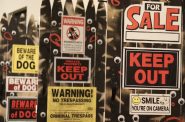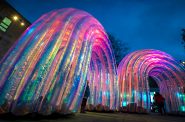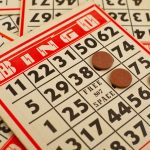Haim Steinbach’s sly “pink accent2”

Haim Steinbach (American, b. Israel, 1944) pink accent2, 1987 Mixed media construction 55 x 110 x 23 in. (139.7 x 279.4 x 58.42 cm) Purchase, with funds from Marianne and Sheldon B. Lubar, Vicki and Allen Samson, and Dr. and Mrs. James Stadler M1987.11
Haim Steinbach’s pink accent2 reads at first like a campy joke from 1987. Two rubber masks, representing hideous mutant heads with even more hideous mini-heads growing from their right temples, sit on a shelf along side a pair of gleaming, domed trash bins and four chrome tea kettles. One of these things is not like the others. Isn’t high art that references pop culture funny?
Ha ha.
That’s the take-away from a casual glance. Naturally, the longer you linger near pink accent2, the more you see in it. The formality of the presentation and its subtle symmetry emerge (rather like those mini-heads) when you examine the piece closely. The objects rest on a mirror-polished chrome shelf that juts from the wall as a steep right-angle triangle. It could be a fixture in a very high-end store.
Steinbach invites you to solve a puzzle. Four objects on the right, but only two on the left? Where’s the symmetry? But think it over: Do those two emerging headlets balance out the two extra tea kettles? Maybe. Now look more closely, and from the left side. The reflective riser stepping to the upper shelf reflects the two heads. So we do have four objects to counterbalance the tea kettles, and in two different manners of speaking, the mirror images and the emerging heads. Well-played, Steinbach. I like the title, too; in 1987, salmon pink was a hot color for high-end interior decorators.
As you observe the piece, you see yourself reflected constantly. Your own face follows you around on the curved cans and kettles. I happen to know that these are high-end home furnishings. The Alessi tea kettle, about $300, features a whistle that doesn’t shriek to announce a boil, but rather plays a sweet chord. There you are, trapped on its surface. You are what you buy.
I take Steinbach’s critique of consumerist society as good-humored and tolerant of human foible. But it is a critique. The smooth, beautiful metals appeal to the touch. (But do resist; fingerprints, you know, and likely ejection from the Milwaukee Art Museum.) The masks, meant to simulate human flesh, are gross and repellent to the touch. That says something, as does the way your own mug takes its place in the line of mirrored fake heads when you view the piece from the left end. When consumption becomes your reason for being, it’s not pretty.
From the right side of the piece you see yourself massed-produced, in five reflections at once in the kettles and one of the trash cans. Finally, Steinbach’s choice of trash cans instead of any other dome shape reminds us of the way of all flesh and all objects of desire. Some day, both we and our stuff will be landfill.
Ha ha.
This is another installment in TCD’s ongoing One Piece at a Time series, focusing on the permanent collections at MAM and other area museums.
Art
-
Winning Artists Works on Display
 May 30th, 2024 by Annie Raab
May 30th, 2024 by Annie Raab
-
5 Huge Rainbow Arcs Coming To Downtown
 Apr 29th, 2024 by Jeramey Jannene
Apr 29th, 2024 by Jeramey Jannene
-
Exhibit Tells Story of Vietnam War Resistors in the Military
 Mar 29th, 2024 by Bill Christofferson
Mar 29th, 2024 by Bill Christofferson




















